How to Arrange Window Boxes: How Many Plants to Add
Ah, the age-old question, “How many plants per window box?” The answer is as varied as the colors in a summer sunset. But fret not, dear garden enthusiast, for this article is here to provide you with a friendly guide, peppered with easy tips and key points to ensure your window box planting is nothing short of spectacular! We’ve been planting window box gardens for decades and we’re happy to share everything we know here at Maker Farm.
The Window Box Planter
Before diving into the world of plants, let’s first select our stage – the window box planter itself. The most important considerations? Good drainage and the amount of light it receives. Drainage holes are essential to prevent excess water, ensuring our plants aren’t drowning. Place your new window box beneath the kitchen window, alongside a window ledge, or along your deck railing. Remember, the best place for your box is where it’ll receive enough light based on your plant choices.
This post contains some affiliate links for your convenience (which means if you make a purchase after clicking a link I will earn a small commission).
Materials Matter
Selecting the right container is the foundation of a successful window box. Consider:
- Wood: Traditional and versatile, wood boxes like cedar and redwood resist rot and offer a classic look.
- Metal: Modern and sleek, metal boxes, especially in materials like aluminum or iron, can offer a contemporary touch.
- Composite: A mix of plastic and wood fibers, these containers are rot-proof and durable. These are my favorite because they are so low maintenance.
Our home’s deck is southwest facing, and it receives a great deal of sun from mid-morning to evening. So our challenge is to keep our plants well watered, even in the dead of summer. Our solution are composite self-watering planters made of propylene that always have some reserve water in them for our plants roots. They are crackproof, fade-resistant, and designed for all seasons. These allow our window boxes to look their best from spring to fall!
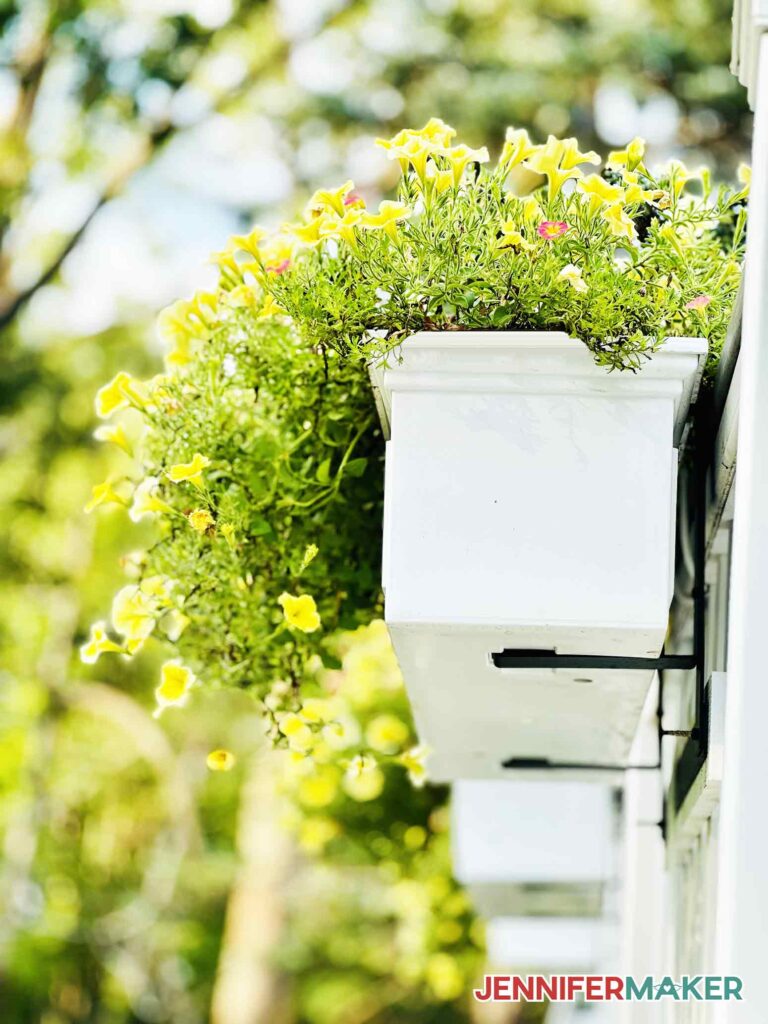
Selecting Plants for Your Window Box
The first thing to determine? How much sun your window box will get. Whether it’s full sun, part sun, or partial shade, knowing the hours of sun is crucial:
- Full Sun: More than 6 hours of direct sunlight.
- Part Sun: About 4-6 hours of sun.
- Partial Shade: 2-4 hours of sunlight.
Colors and Themes
- Monochromatic: Stick to one color in varying shades.
- Contrasting: Pair opposite colors from the color wheel for a dynamic look.
- Seasonal: Rotate plants based on the season – pansies in spring, petunias in summer, and ornamental kale in fall. Or make it easy and plant multi-color zinnias from spring thaw to first frost!
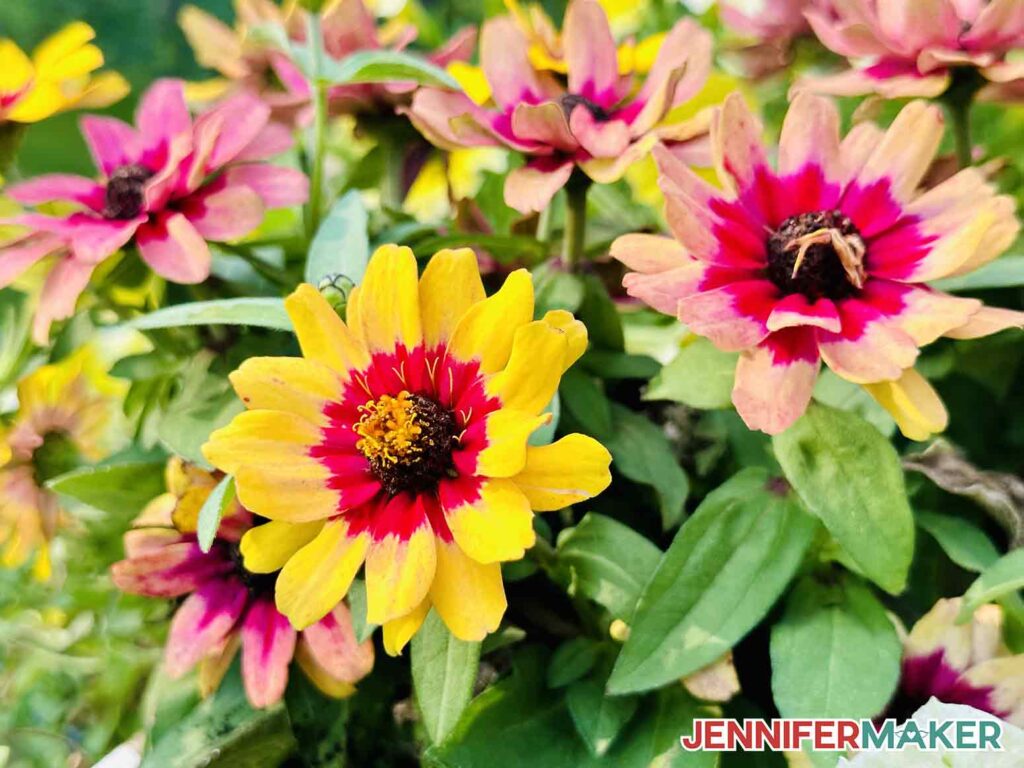
The Process of Arrangement
1. Begin with Thrillers
Thrillers are the tall, eye-catching plants, your focal point. Place them at the back or center, depending on the window box’s visibility. Consider plants like purple fountain grass, snapdragons, or tall verbena. Zonal geraniums or dwarf conifers can be a good choice, too, anchoring your design. One of the best plants for a thriller is celosia, also known as Cockcomb.

Fun Fact
Our daughter Alexa nicknamed the yellow ones “honey pinecones” when she was little and the name has stuck in our family.
2. Add Fillers
Fillers are the mid-sized, mounding plants that fill the space. Surround your thrillers with vibrant fillers like petunias, calibrachoas, or heliotropes. White flowers, for instance, can add a touch of elegance. For full sun, sweet potato vine or ornamental sweet potato offer vibrant foliage. For cooler weather, consider foliage plants like dwarf conifers. We also like marigolds, as they won’t grow to overwhelm the thrillers and are always colorful!
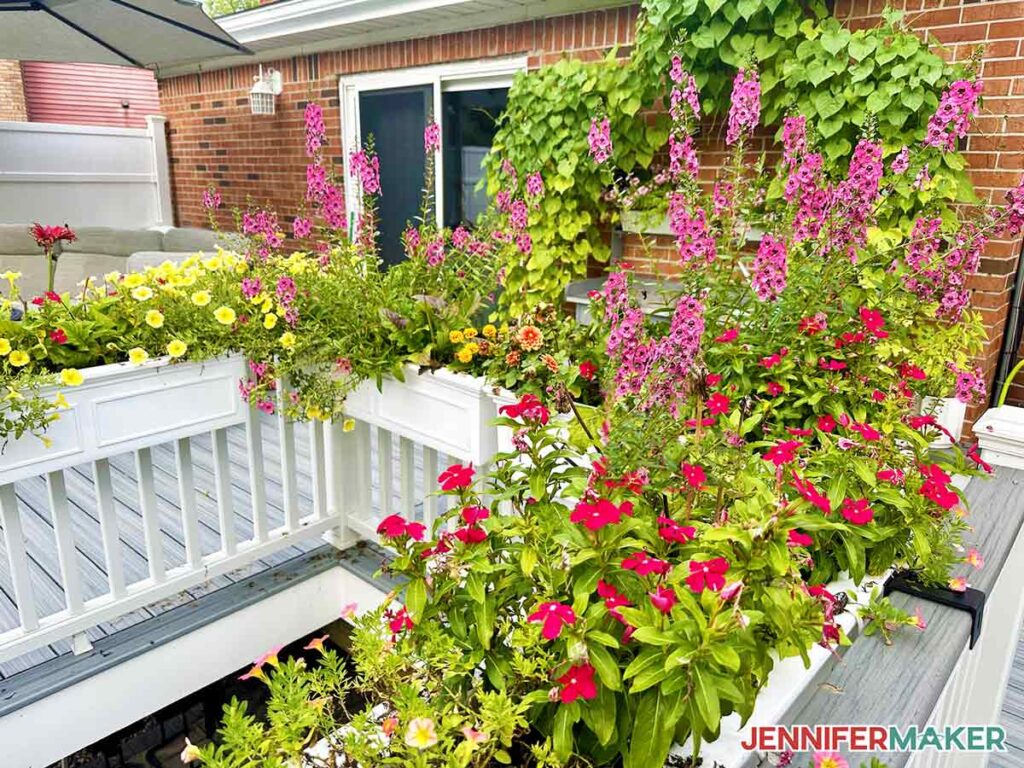
Fun Fact
Planting marigolds in your window boxes are great idea if you live in an area with a lot of squirrels, as marigolds repel squirrels who would otherwise dig in your planters to hid their nuts. Marigolds also keep mosquitos away, so they’re a great idea for deck planters.
3. Finish with Spillers
Spillers are the training plant that drapes over the edge, softening the box’s look. Trailing plants like ivy, sweet potato vines, or wave petunias are perfect. Wave petunias or a trailing cherry tomato variety would drape gracefully over the edge of the box.
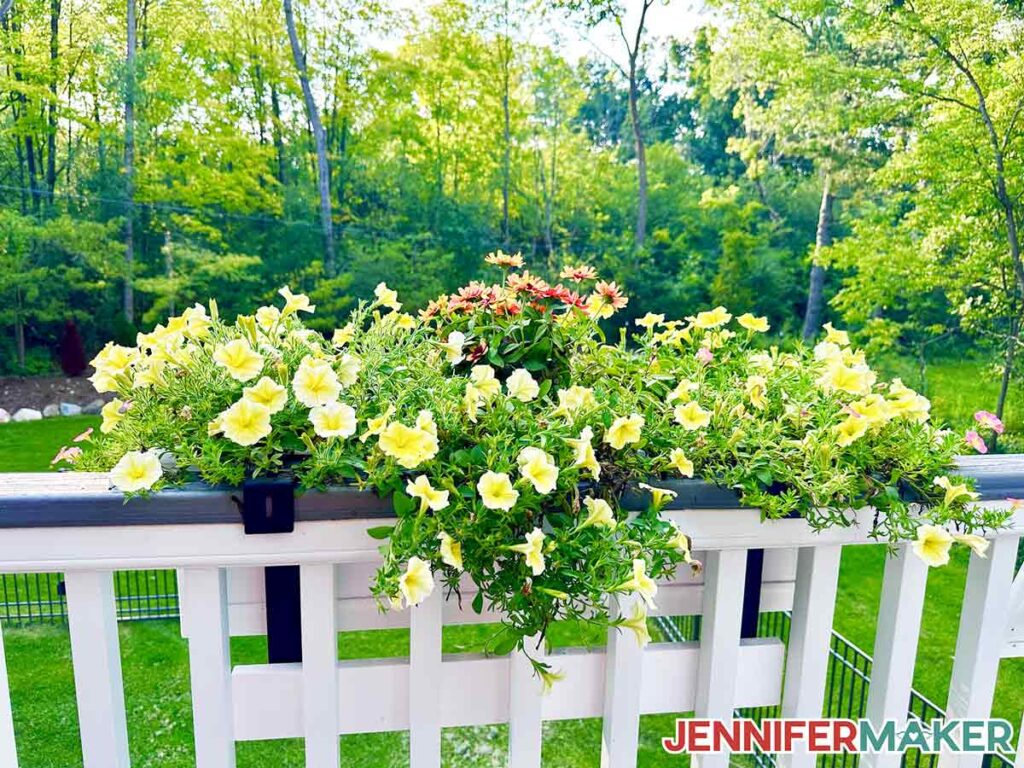
Did you know?
Petunias love to spread, and they may crowd out your other plants. So if you want a very simple window box, you could plant just wave petunias, which will both mound and trail. Combine colors for the best look!
How Many Plants?
The number of plants largely depends on the size of your window box planter. A good rule of thumb?
For 12-inch planters, three to five (3-5) different plants ensure diversity without overcrowding. I recommend one thriller and two fillers in these smaller window boxes. If you feel you have the room, you can add two
For 24-inch planters, you can fit five to seven (5-7) plants. We recommend one thriller, two to four fillers, and two spillers.
For 36-inch planters, you can fit eight to ten (8-10) plants. We recommend two thrillers, four to six fillers, and two spillers. My planters are 36 inches wide.
Remember, fewer plants can be effective too, especially with larger species or spreading plants like petunias. Always ensure enough room for the roots of the plants to grow. My planters are 11″ high with a self-water insert, which my plants just seem to love!
Cultivating Success: Plant Care
- Potting Mix: Start with a fresh potting soil mix. Some gardeners love adding sphagnum moss for added moisture retention.
- Watering: Good drainage is essential, but so is moist soil. Self-watering window boxes or an irrigation system can be a game-changer, especially in dry areas. I highly recommend a self-watering window box as I feel it really makes a difference.
- Fertilization: A liquid fertilizer or water-soluble fertilizer gives your plants the nutrients they need.
Fun fact: You can install watering systems to keep your window box plants thriving, as we’ve done in our planters! We used this watering system, as pictured here.
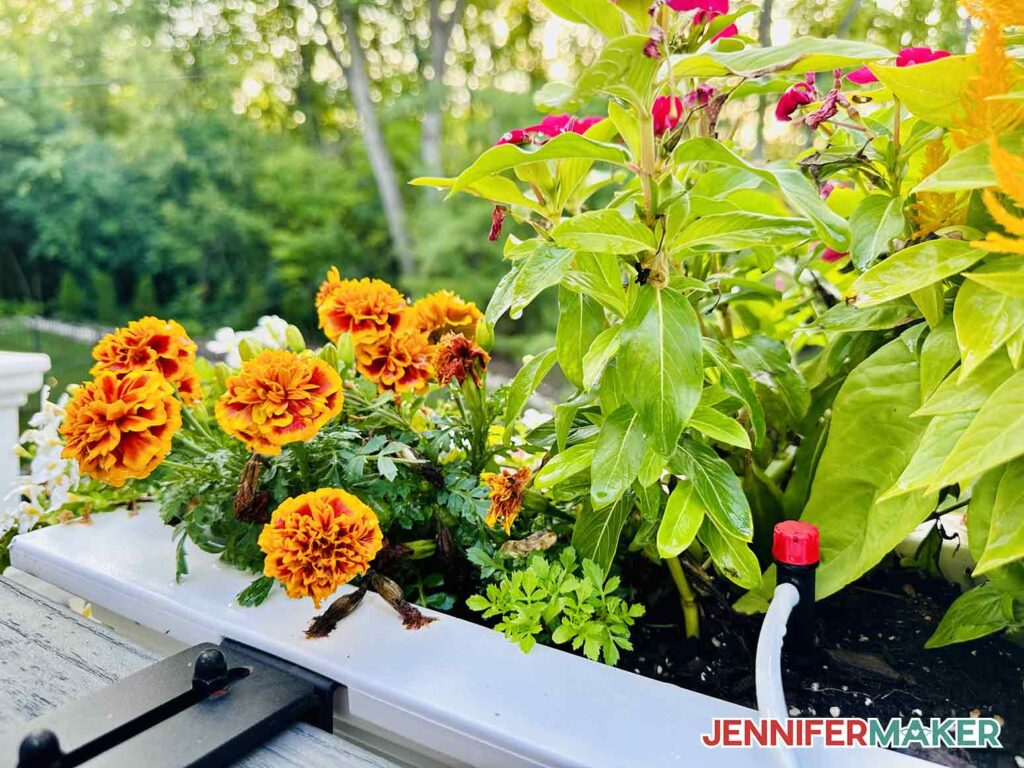
Other Considerations
- Growing Season: Think about the time of year. Early summer selections might differ from late summer or late spring choices.
- Maintenance: Some plants are low maintenance, while others might need frequent watering or deadheading.
- Creativity: Don’t be afraid to experiment! One year, you might adore colorful flowers, and the next year, you might opt for a lush foliage display.
Ongoing Care and Maintenance
- Watering: Ensure consistent moisture but avoid waterlogging. Most window boxes need watering every day, especially in the heat. If you use self-watering window boxes as we do, you can usually skip a day when needed.
- Fertilization: Use a balanced, slow-release fertilizer to support continuous growth.
- Pruning: Regularly deadhead flowers to encourage new blooms and maintain a neat appearance.
Our Conclusion
Crafting the ideal window box arrangement is an art that marries aesthetics and horticulture. By carefully selecting your container, understanding your plants, and arranging them thoughtfully, you’ll create a window display that is not just a sight to behold but also a reflection of your personal style and love for nature.
Window boxes are a great way to maximize small spaces and add curb appeal. From flower beds on your window frame to container planting by the window ledge, the possibilities are endless. So, roll up those sleeves and let the magic of window box gardening begin!
Happy planting!
